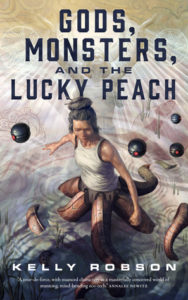For the epigraph to Gods, Monsters, and the Lucky Peach, Robson riffs on the old saying about the past being a foreign country. Instead of “they do things differently there” she has “we want to colonize it.” That’s the first indication that her novella will eventually be a time-travel story. The next is the abrupt shift between a three-paragraph opening scene that features a mythical tone, with a monster that “looked like an old grandmother from the waist up, but it had six long octopus legs,” followed by scenes in a semi-distant future Calgary with “plague babies” who have worked together for more than 60 years, and “fakes” that are something like computer-generated avatars with a generous helping of AI. No wait, the second clue that this is going to be a time-travel story is that after the monster recoils and hisses when the king appears to do battle, it says Oh-shit-shit-shit-shit.
It doesn’t take readers long to learn that Minh, Robson’s main point of view character for the future scenes, has the same number of limbs as the monster that the king Shulgi is battling in those initial three paragraphs. How will their worlds collide? (Presuming, of course, that the number of appendages is not a coincidence.) That’s one of the main throughlines of Gods, Monsters, and the Lucky Peach. Minh’s future world is a bleak one, though from Robson’s descriptions, not as bleak as its recent past. In Minh’s world’s history, total ecological collapse drove humanity to live underground for generations; most people live there still. Minh is one of a relatively small number of people who live in “habs,” attempting to recolonize the surface of the Earth.
In the interim, humanity has developed serious biological modification technology, of which Minh’s extra legs are the story’s most prominent example. During the course of the tale, one of the characters undergoes radical transformation to prove a point; that illustrates how routine this technology has become. And of course there’s time travel, whose workings have been kept hush-hush by the CERN-like agency that developed it. (The agency is even called TERN.) That keeps the traveling sufficiently vague for modern sensibilities but not impossible, because otherwise it would be very difficult indeed to write a time-travel story. I don’t quite buy Robson’s setting — the desertification that she has her characters trying to mitigate would, I think, be impossible to recover from, and ecological catastrophe bad enough to drive the human species underground would also suffice to kill it — but I am willing to roll with it for the sake of the story.
Another strong aspect of Gods, Monsters, and the Lucky Peach is the eventual uncertainty about which characters are meant to earn readers’ sympathies. Not all of the scenes from antiquity with Shulgi are as short as the first one, and Robson shows him sympathetically in a conflict with the local clerics. She also shows him at the top of a very exploitative social system. And then there’s the matter of whether he really will be coming into deadly conflict with Minh by the end of the story. Minh herself may be just as manipulative of the social order around her as Shulgi is of his, at least when she has the opportunity. She is hemmed in by Fabian, a representative of TERN, who may be just the latest in the line of science fiction’s malevolent corporate schemers, or he may be both a scientist and an enthusiast. Minh’s strengths, for example, are exactly also her weaknesses, and Robson does a terrific job in showing her characters’ flaws flowing from their advantages.
I found the pacing of the novella a bit odd. The first third felt very much like twenty-first-century corporate life transported onto an utterly transformed Earth. That seemed out of place, as if Uber were working by the rhythms of the Dutch East India Company. The corporate assembly of character lets Robson explicate more of the future setting and develop the relationships among most of the eventual travelers. On the other hand, the group does not even arrive at the time-travel center until about page 48 of 113. That much prologue struck me as belonging to a longer work, or perhaps cuttable to concentrate on what Gods, Monsters, and the Lucky Peach is clearly driving toward.
Once the characters are launched into antiquity, the story convincingly portrays how mixed motives, shifting personal alliances, and the combination of business and science could shape a semi-exploratory journey into the past. Things go wrong, dreadfully wrong. Then there’s the king who wants to dispatch the monster from his realm, and it turns out he’s not the only power in antique society…
When it gets going, Gods, Monsters, and the Lucky Peach is tense and fun, with surprises through to the end. It’s not the kind of book in which everyone is guaranteed to escape unscathed, and indeed they do not.

